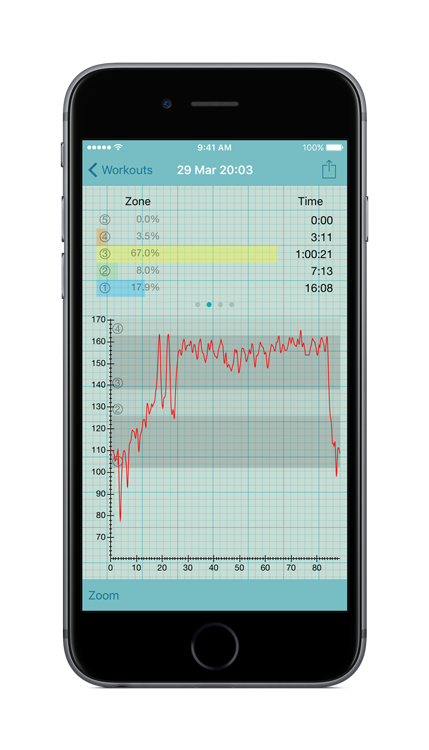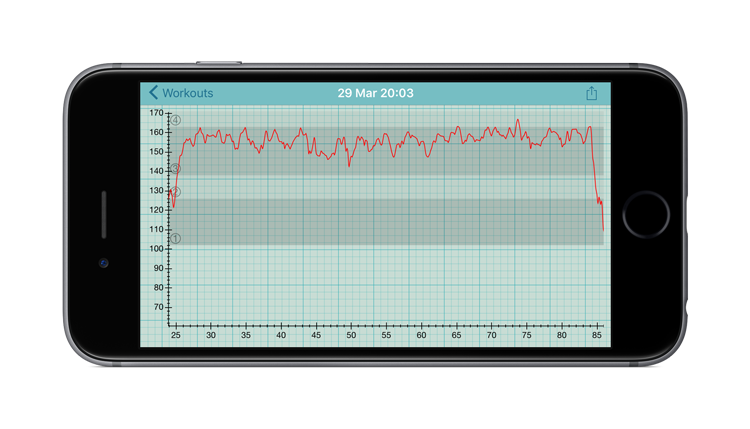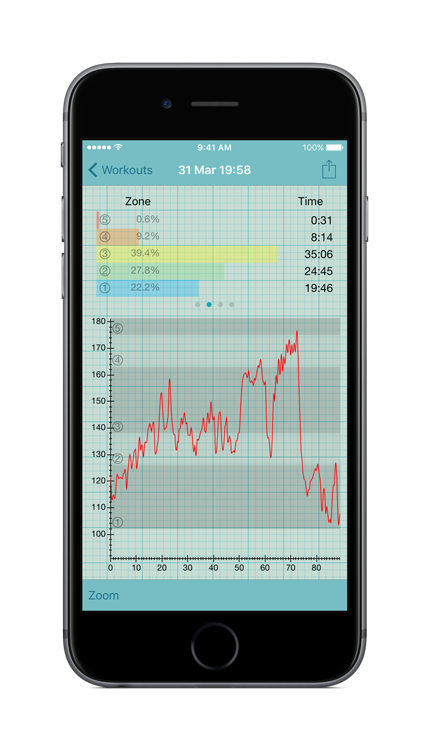In a previous article, we’ve discussed Training using heart rate zones, which gives some of the theoretical details about defining and using heart rate zones in your training. In this article, we take a look at how monitoring heart rate and the use of heart rate zones has supported a particular type of exercise session: 1 hour of cycling effort purely in the aerobic zones (Zones 1, 2 and 3). This type of training is particularly important for building endurance and preventing fatigue caused by exercising above your anaerobic threshold. When cycling, such a session can often be useful during the winter when getting out on the bike may be happening less frequently, and group rides are slower than they might be during the summer racing season.
To understand the session, let’s take a look at graph of heart rate against time for the 90 minutes or so this session took using the screenshot below. Initially the heart rate started around 100bpm, then during 20-25 minutes of warm up rose to around 155. By monitoring heart rate during their session, our cyclist was able to control their effort to ensure that the heart rate didn’t go above the anaerobic threshold (AT) boundary between Zone 3 and Zone 4 for any significant period of time during the main hour-long effort of the workout. After completing the work, a 5 minute cool-down easily brings the heart rate back to normal levels.
This effort is then summarised in the bar graphs at the top of the screen, which show that just over 60 minutes is spent in Zone 3 (yellow), and that the only other significant time in the workout is spent in Zone 1 and Zone 2 (from the warm-up and cool-down periods). That pattern is the hall-mark of this kind of session – any significant time in Zone 4 or Zone 5 would be a sign that too much effort was being expended, and would like also show as a prolonged period required to bring heart rate back to normal levels at the end of the workout.
It’s interesting to note the two sharp spikes at around 19 and 22 minutes, which were recorded during the warm-up period. Our cyclist did these short bursts of near-max intensity to allow themselves to more easily get their heart rate up to the desired level for the actual work of the session. While this may not be true for everyone, our cyclist here finds that without a short burst of effort during the warm-up it can be difficult to comfortably maintain their heart rate near the anaerobic threshold, or indeed to even get it there in the first place!
Zooming in to the hour-long period of work gives even more detail to understand what happened during this session: as you would expect, it is hard to keep heart rate constant while training (even on a turbo-trainer!), and so it varies throughout the workout. However, our cyclist has carefully ensured that whenever it gets near the anaerobic threshold boundary they’ve eased off, and if it drops too low then a little more effort is put in.
Acknowledgements
![]() All images shown in this article are screenshots taken showing actual data recorded by Heart Graph for iOS and Apple Watch. Find out more about the features of Heart Graph by viewing our Tutorial Videos.
All images shown in this article are screenshots taken showing actual data recorded by Heart Graph for iOS and Apple Watch. Find out more about the features of Heart Graph by viewing our Tutorial Videos.
About the author
Dr Thomas Wright, Director of Smoky Cat Software Ltd., studied at the University of Oxford, and has spent 1000s of hours rowing and coaching rowing, and road-cycle racing. As well as being Men’s captain of St Catherine’s College Boat Club in 1997/98, he also participated in the University Lightweights Summer Squad in 1998, competing in an eight at the Henley Royal Regatta. As a member of the Oxford City Road Club, he was awarded the Frank Wraight Memorial Trophy in 2003 as the club’s cycling road race champion.

